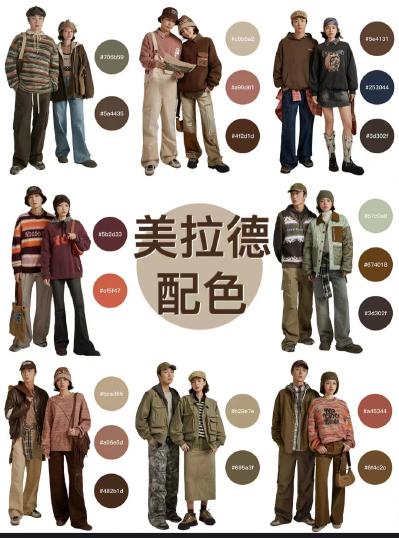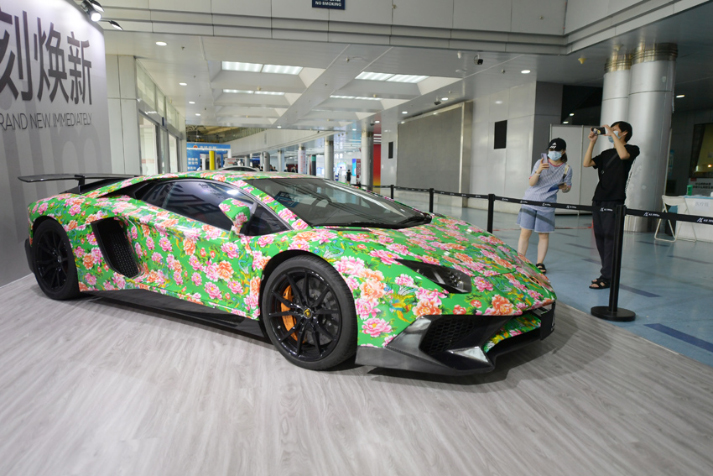| Lifestyle |
| China's urbanites begin winterizing their wardrobes | |
|
|
 Netizens show how to mix and match Maillard style colors on Chinese lifestyle and e-commerce app Xiaohongshu (Little Red Book). Many believe the brownish color combinations can lift any look and make them appear "good enough to eat" (FILE)
The hot, hip and happening razzmatazz of Shanghai Fashion Week Spring/Summer 2024 was a wrap on October 16. Starting from October 8, the couture concoctions of more than 100 (mostly Chinese) creative minds took to the catwalks from the city's Xintiandi shopping district to its famous Bund waterfront area, satisfying the ravenous appetites of fashion aficionados, editors and buyers alike in a post-pandemic, boisterous blaze of light and lacy luminosity. From the catwalk to just, well, a "walk," a 2.5-hour flight north, Beijingers at the same time enjoyed a front-row seat to another flashy form of art—arboreal art, that is. Residents were soaking up the (short-lived) splendor that is fall in the capital, a place surrounded by thousands of acres of fall foliage ranging from canary yellow to flaming red, in neighboring mountains covered with maple, ginkgo, smoke and torch trees—and many more. But from a more fashionable perspective, sandwiched between a scorching summer and a season of brutally bone-chilling winds, many urbanites felt it was time to begin winterizing their wardrobes. Yours truly was no exception to this unwritten rule and with great anticipation opened her closet to bring back to full clothes hanger prominence… A flaming red dongbei dahua ("northeast floral pattern," a traditional fabric pattern featuring large peony flowers) padded jacket. Scrolling through some of China's most popular apps, such as Taobao (Alibaba's mobile shopping platform), Xiaohongshu (Little Red Book, a wildly popular lifestyle and e-commerce app) and Douyin (China's version of TikTok), the uptick in searches for both hot-to-trot winter styles and traditional northern Chinese culture-inspired items was noticeable from early October onward. The question remains… How do Chinese millennials and Gen Zs, particularly those in the country's coldest areas in the north, plan to season their (padded) styles with some panache in Fall/Winter 2023? Food meets fashion With fall already upon China, the nation's fashion scene has shifted away from the dopamine dressing trend that dominated summer. Netizens, Gen Zs in particular, considered this colorful, splashy styling a whimsical way to lift their mood amid the pressures of life and work. The trend was one tasty summer season treat—with rainbow sprinkles on top. If we go by our Xiaohongshu findings, scrolling through the thousands of celebrities and influencers showing off their outfits, accessories and nails, the preferred mode for the colder months of the year is now a more subdued style, known as Maillard style. Fast fact for foodies and fashionistos: Maillard fashion is named after the Maillard reaction, the chemical reaction between amino acids and sugars that causes food to brown when heated, creating the rich flavors and golden brown color we enjoy on everything, from steaks to crème brûlée. Inspired by this well-known culinary process, the Maillard style features a wide range of autumnal tones, from browns to colors that pair well with the toasty palette, such as burgundy, khaki and cream. In contrast to the dopamine dressing that reigned supreme this summer, the new flair fad's enduring, deep-toned, earthy colors capture the essence of the lush autumnal surroundings while bringing out a sense of comfort and warmth, as well as evoking images of seared steaks, roasted coffee, baked goods and toasted marshmallows. The trend is the taste of the town and the social media numbers don't lie. For instance, hashtag "fall Maillard style" had 10.3 million related short videos on Douyin as of October 19. Many Chinese netizens commented the brownish color combinations can lift any look and make them appear "good enough to eat."  The colorful peony pattern of China's northeast may have become the cat's meow in the Chinese fashion world, but it has also expanded to other sectors, including automobile manufacturing as demonstrated at an auto show in Changchun, Jilin Province, in 2021(CNSPHOTO)
Guochao reigns Supreme The Maillard modish mayhem appeals to fashion aficionados based all over China, but those residing in its northern regions, where the mercury plummets into the depths of frozen despair in winter, also consider the intense bite of the cold when tailoring their outfits to the trendiest taste buds, such as the northeast floral pattern padded tops. And bottoms. As the name suggests, this design originated in the northeastern regions of China (including Liaoning, Jilin and Heilongjiang provinces). Its distinctive and contrasting colors—red and green—are not necessarily in line with China's contemporary aesthetics, but their mixing and matching with floral patterns is not uncommon in Chinese history. Fast fact for architecture aficionados: multiple shades of red and green also recur in ancient Chinese structural design, one example thereof being Beijing's Forbidden City. In more modern times, the red and green floral pattern is a winter wardrobe staple in north China, especially coming to life on padded jackets and bottoms. Some residents of the region explain the preference for these colorific flowery decorations as a reaction to the whiteness of winter. With snow-white plains as far as the eye can see, residents tend to dream of spring when they're getting dressed in the morning. Close your eyes, think of any 1990s movie directed by Zhang Yimou and starring actress Gong Li, and this reasoning actually makes sense. After China's economic reforms started in the late 1970s, Chinese society changed swiftly. And so did people's tastes. Changing consumer habits, a more global outlook on life, better, more extensive education and amplified exposure to a variety of visual media are often cited as the main reasons for such a significant generational gap in style and aesthetics, according to ChinaNauts, an online magazine analyzing contemporary China, in 2021. Younger Chinese netizens tend to associate the traditional northeast floral pattern with being tu (literally "earth," but also "unrefined" or "outdated"). But with tens of thousands of likes and comments on, for example, Xiaohongshu, not to mention the host of "dongbei dahua styling tutorials" on the platform this October, one might wonder… How on Earth did the floral pattern of China's northeast has become the cat's meow on Chinese social media in the Roaring Twenties 2.0? According to this author, its rebirth in the realm of uber-stylishness can probably be attributed to the top trend dominating the Chinese fashion landscape since 2018: guochao (literally "national wave," but basically meaning "hip heritage"). Fast fact for all those interested in contemporary Chinese cultural essentials: Guochao is a term that refers to trends and styles mixing contemporary design, high technology and strong references to Chinese culture and traditional products. Guochao may have started with (street) fashion but it has over the past five years expanded to include the toy manufacturing, art and food sectors, among others. One recent example in the food and beverage scene is coffee giant Luckin's latte flavored with Moutai, the most expensive brand of baijiu—a strong Chinese spirit. In early September, on the day of its launch alone, Luckin sold more than 5.42 million cups of the latte flavor, according to the company. From the food and beverage scene, we circle back to the style scenery. When Italian high-fashion brand Marni released its Spring 2018 ready-to-wear collection, the garments began trending on Chinese social media due to the label's use of a fabric that bore a striking resemblance to the northeast floral pattern. And when American streetwear brand Supreme, incredibly popular in China's first-tier cities, launched a 2021 collection incorporating the traditional Chinese peony pattern, the latter was back for good, reigning supreme in the lookbooks and wardrobes of young Chinese ever since. Summing up, 'tis the season to wrap yourself in some padded northeast floral pattern pajamas, get yourself a Moutai latte and stay snug as a bug. In style. Copyedited by G.P. Wilson Comments to elsbeth@cicgamericas.com |
|
||||||||||||||||||||||||||||||
|
